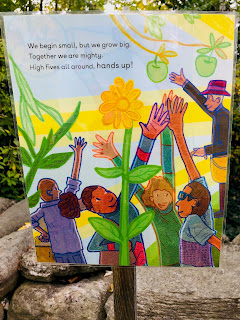We thank Emily Rinkema, proficiency-based learning coordinator and educator extraordinaire, for this guest post.
This year, CVU implemented a significant schedule change in the middle of a global pandemic. While any significant change during such a time may seem like a risky idea, one that added transitions to an already hectic day, required widespread participation of already overwhelmed humans, cut academic time in classes that already felt overpacked, and depended upon last minute flexibility in an already over-flexed system may seem like a downright stupid idea.
Believe us, there have been times (and still are weekly), when we believe it was a downright stupid idea. But then we walk around the building during C3, the 20 minute block (with 5 minute passing on either side) between blocks three and four. There are students painting each other’s nails in Nail Salon, singing along to classic rock and doing puzzles in Music and Puzzles, shooting baskets in Open Gym, talking about sustainability in the Environmental Action Club, planning a campaign to increase understanding about gender in the Gender Sexuality Alliance, learning to breathe in the Meditation and Mindfulness Club, and learning about strategy in the Investment Club. In some classrooms there are just a few students connecting with their teachers about classwork, in others there are dozens who chose to be in a space with students who have similar interests. Some rooms are silent, with students reading together, and others are filled with students cheering each other on in a massive game of Uno.
C3 stands for Connect, Clubs, and Communities, and was born out of the need to increase equity of access to clubs, increase opportunities for belonging, and provide the time and space for teachers and students to connect academically and socially. It is a regular part of every school day, though Fridays during C3 are currently being used to have an extended advisory experience.
The first C, Connect, is not new to CVU. We have tried different versions of Connect in the past, and while teachers and students found it valuable, there were many things that prevented it from catching on in our system. This year, the regularity, increased time, and improved scheduling software have made it the most successful iteration of Connect yet. Teachers can request students to meet with them, and students can request to meet with teachers. Connect is often a time to check in about a skill or concept that a student is struggling with, to finish an assessment started in class, or to be proactive about upcoming absences. Most students only connect once a week at most, which allows plenty of opportunities for the other two Cs.
The second C is for Clubs. In the past, clubs met before or after school, which significantly limited accessibility. Students who couldn’t get rides to or from school often couldn’t participate, and students who had other activities or responsibilities couldn’t participate. There were also limited numbers of clubs, as club advisors also had to be available before or after school. Now, all clubs meet during the actual school day, so every student can access them (some clubs also meet after school in order to do the activities involved with the club), and because there are four days of C3, many students are now involved in multiple opportunities.
As of this week, we have 55 clubs and 28 communities for students to choose from, but this changes week to week as students and adults propose new opportunities.
 |
| Board Games |
C3 implementation has not been easy. We are still figuring out ways to shift our systems and make adjustments so that we can sustain and continue to grow what we know is a valuable program. Students have been amazing--so excited about getting to try new opportunities and find what they love to do, whether it’s learning how to debate formally or spending time making friendship bracelets with their peers. Faculty and staff have been so patient and flexible, filling in where needed at the last minute, volunteering to facilitate communities that students suggested (who knew so many high schoolers would want to play pickleball?), and adapting their long-standing clubs to fit a new schedule. And the administrators have been brave and creative and supportive and encouraging, even when the thought of 1,200 students making choices about where they want to be and what they want to do may keep them up at night.
While moving forward with an idea like C3 during a global pandemic was a risky idea, it was the right idea. I am proud to work in a school and be in a community that doesn’t shy away from risk when it comes to doing the right thing for our students.














